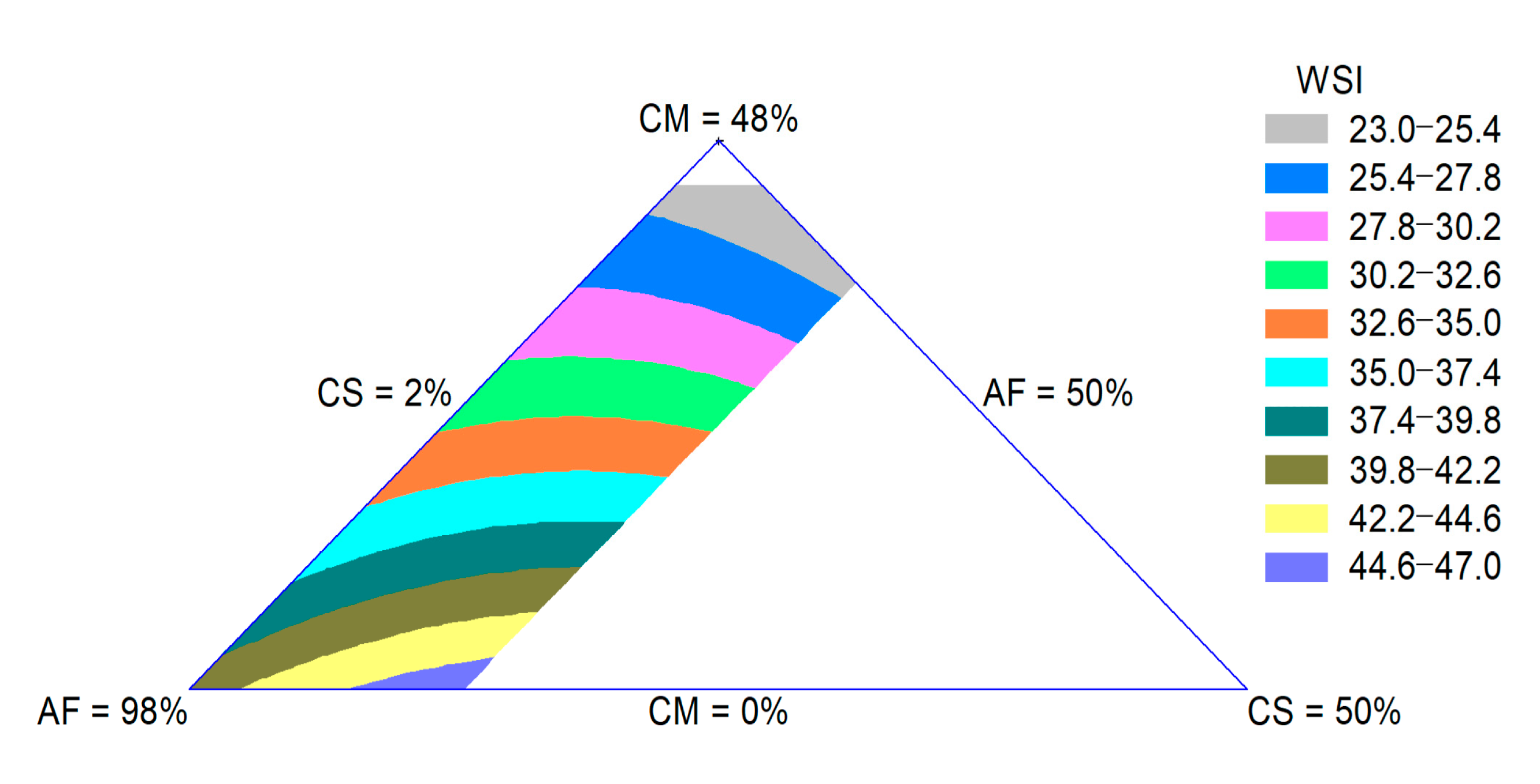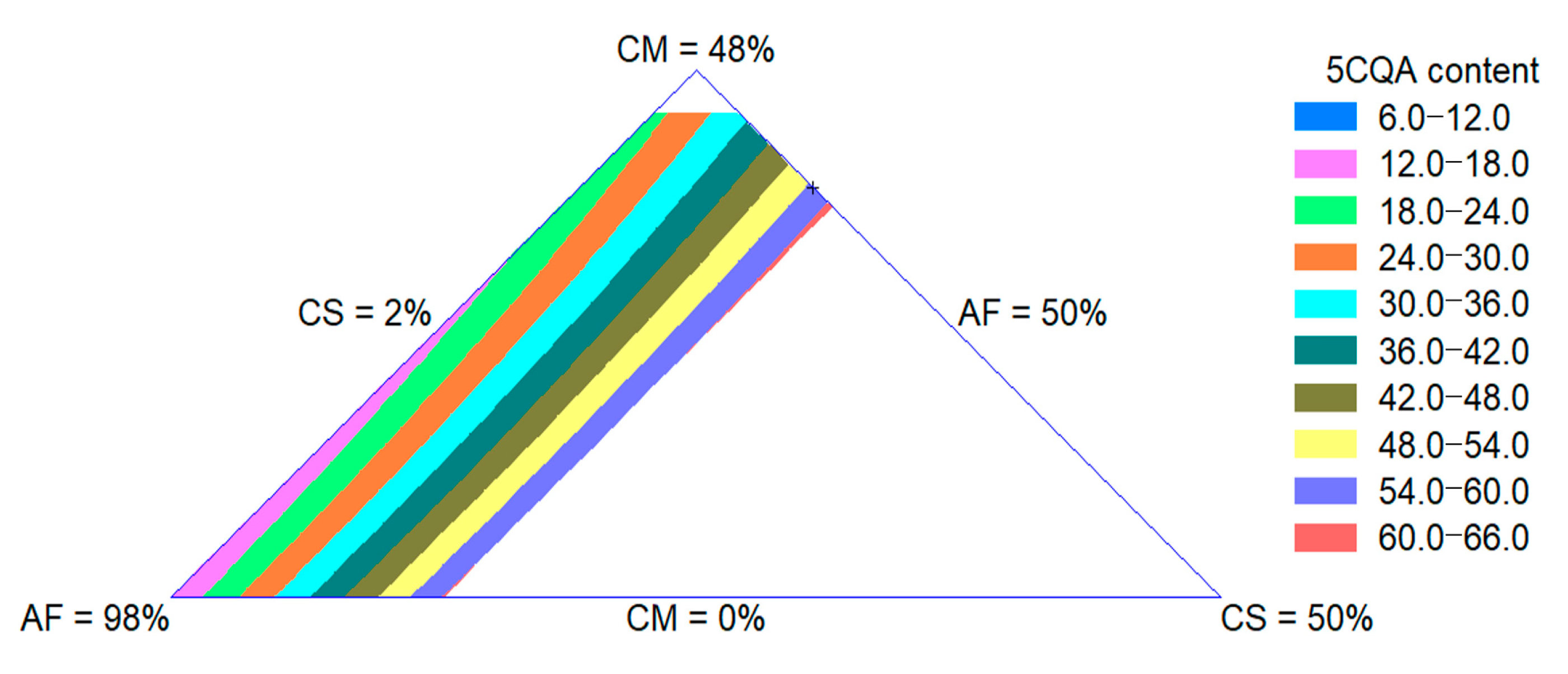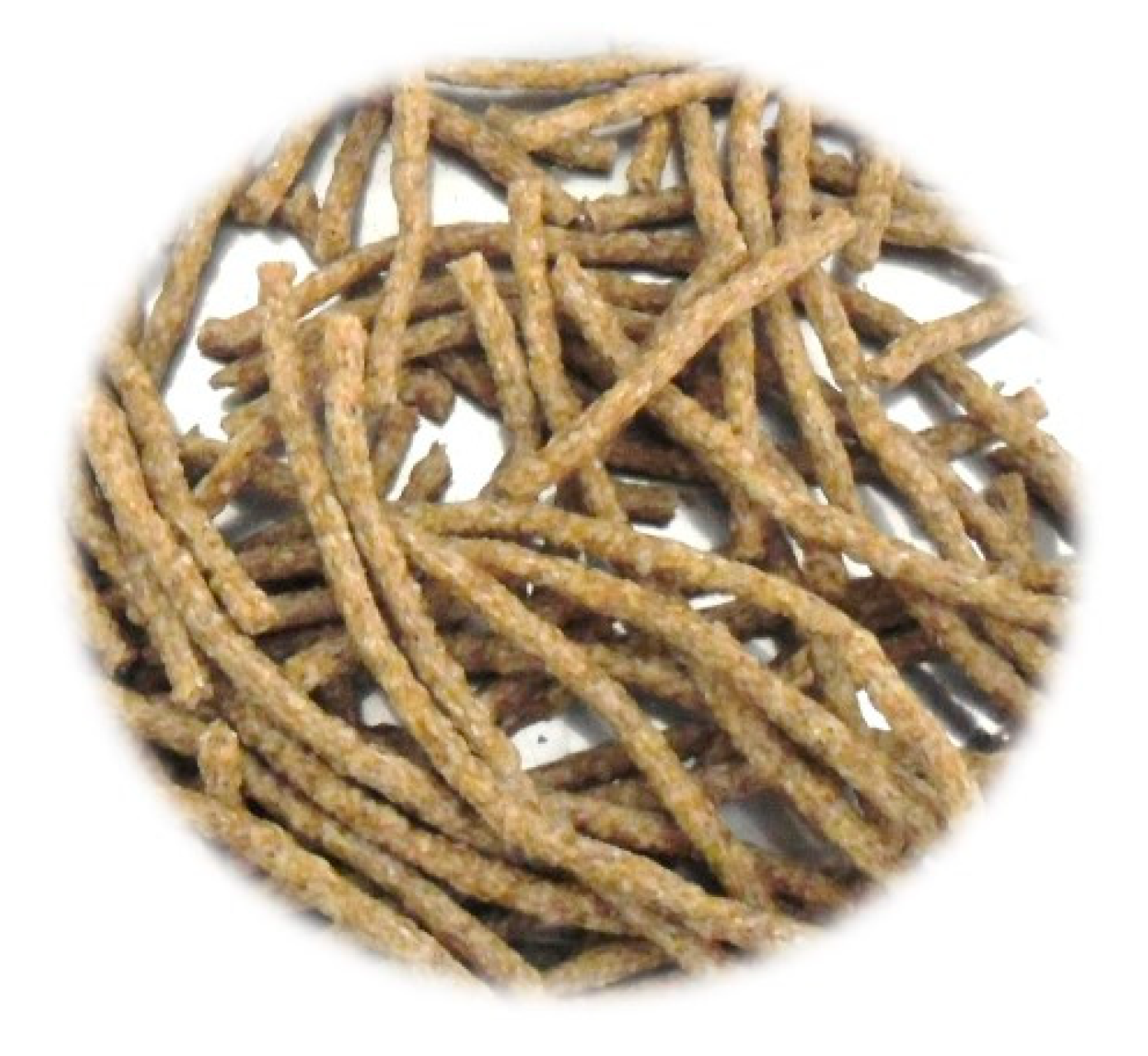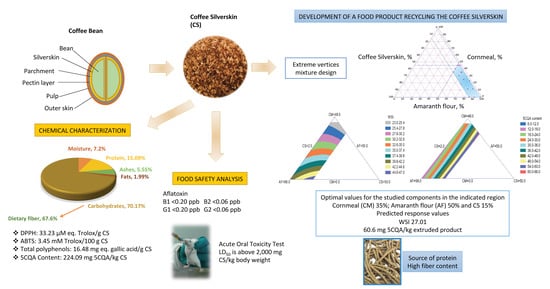Evaluation of the Use of a Coffee Industry By-Product in a Cereal-Based Extruded Food Product
Abstract
:1. Introduction
2. Materials and Methods
2.1. Materials
2.2. CS Characterization and Microbiological Quality
2.2.1. Bromatological and Microbiological Analysis
2.2.2. Total Dietary Fiber (TDF)
2.2.3. Extraction Method
2.2.4. Total Polyphenol Determination
2.2.5. Antioxidant Activity
2.2.6. HPLC Analysis
2.3. CS Toxicological Analysis
2.4. Product Development
2.4.1. Extrusion Cooking
2.4.2. Water Solubility Index (WSI)
2.4.3. Experimental Design
2.5. Statistical Analysis
3. Results and Discussion
3.1. CS Characterization and Microbiological Quality
3.1.1. Bromatological Composition
3.1.2. Microbiological Determinations
3.1.3. Antioxidant Capacity and Total Polyphenol Content
3.1.4. Quantification of 5CQA
Method Performance
5CQA Content in CS
3.2. Toxicological Aspects
3.3. Product Development
3.3.1. Product Formulation
3.3.2. WSI and 5CQA Content in Extruded Products
4. Conclusions
Author Contributions
Funding
Acknowledgments
Conflicts of Interest
References
- Laufenberg, G.; Kunz, B.; Nystroem, M. Transformation of vegetable waste into value added products: (A) the upgrading concept; (B) practical implementations. Bioresour. Technol. 2003, 87, 167–198. [Google Scholar] [CrossRef]
- Elleuch, M.; Bedigian, D.; Roiseux, O.; Besbes, S.; Blecker, C.; Attia, H. Dietary fibre and fibre-rich by-products of food processing: Characterisation, technological functionality and commercial applications: A review. Food Chem. 2011, 124, 411–421. [Google Scholar] [CrossRef]
- Sharma, S.K.; Bansal, S.; Mangal, M.; Dixit, A.K.; Gupta, R.K.; Mangal, A.K. Utilization of Food Processing By-products as Dietary, Functional, and Novel Fiber: A Review. Crit. Rev. Food Sci. Nutr. 2016, 56, 1647–1661. [Google Scholar] [CrossRef] [PubMed]
- Klingel, T.; Kremer, J.I.; Gottstein, V.; Rajcic de Rezende, T.; Schwarz, S.; Lachenmeier, D.W. A Review of Coffee By-Products Including Leaf, Flower, Cherry, Husk, Silver Skin, and Spent Grounds as Novel Foods within the European Union. Foods 2020, 9, 665. [Google Scholar] [CrossRef]
- Caldeira, C.; Vlysidis, A.; Fiore, G.; De Laurentiis, V.; Vignali, G.; Sala, S. Sustainability of food waste biorefinery: A review on valorisation pathways, techno-economic constraints, and environmental assessment. Bioresour. Technol. 2020, 312, 123575. [Google Scholar] [CrossRef]
- Mussatto, S.I.; Machado, E.M.S.; Martins, S.; Teixeira, J.A. Production, Composition, and Application of Coffee and Its Industrial Residues. Food Bioprocess Technol. 2011, 4, 661–672. [Google Scholar] [CrossRef] [Green Version]
- Belitz, H.D.; Grosch, W.; Schieberle, P. Coffee, Tea, Cocoa. In Food Chemistry, 4th ed.; Springer: Berlin/Heidelberg, Germany, 2009; pp. 938–942. [Google Scholar]
- International Coffee Organization. Available online: www.ico.org (accessed on 1 July 2020).
- Ballesteros, L.; Teixeira, J.; Mussatto, S. Chemical, functional, and structural properties of spent coffee grounds and coffee silverskin. Food Bioprocess Technol. 2014, 7, 3493–3503. [Google Scholar] [CrossRef] [Green Version]
- Alves, R.C.; Rodrigues, F.; Nunes, M.A.; Vinha, A.F.; Oliveira, M.B.P.P. State of the art in coffee processing by-products. In Handbook of Coffee Processing By-Products; Galanakis, C.M., Ed.; Academic Press Elsevier: London, UK, 2017; pp. 1–21. [Google Scholar]
- Bresciani, L.; Calani, L.; Bruni, R.; Brighenti, F.; Del Rio, D. Phenolic composition, caffeine content and antioxidant capacity of coffee silverskin. Food Res. Int. 2014, 61, 196–201. [Google Scholar] [CrossRef]
- Bondesson, E. A Nutritional Analysis on the By-Product Coffee Husk and its Potential Utilization in Food Production. Bachelor’s Thesis, Swedish University of Agricultural Sciences, Uppsala, Sweden, 2015. [Google Scholar]
- Abdeltaif, S.A.; SirElkhatim, K.A.; Hassan, A.B. Estimation of Phenolic and Flavonoid Compounds and Antioxidant Activity of Spent Coffee and Black Tea (Processing) Waste for Potential Recovery and Reuse in Sudan. Recycling 2018, 3, 27. [Google Scholar] [CrossRef] [Green Version]
- Meng, S.; Cao, J.; Feng, Q.; Peng, J.; Hu, Y. Roles of chologenic acid on regulating glucose and lipids metabolism: A review. Evid. Based Compl. Alt. 2013, 1, 1–11. [Google Scholar] [CrossRef]
- Murthy, P.S.; Naidu, M.M. Sustainable management of coffee industry by-products and value addition-A review. Resour. Conserv. Recy. 2012, 66, 45–58. [Google Scholar] [CrossRef]
- Tajik, N.; Tajik, M.; Mack, I.; Enck, P. The potential effects of chlorogenic acid, the main phenolic components in coffee, on health: A comprehensive review of the literature. Eur. J. Nutr. 2017, 56, 2215–2244. [Google Scholar] [CrossRef] [PubMed]
- Naveed, M.; Hejazi, V.; Abbas, M.; Kamboh, A.; Khan, G.J.; Shumzaid, M.; Ahmad, F.; Babazadeh, D.; FangFang, X.; Modarresi-Ghazani, F.; et al. Review Chlorogenic acid (CGA): A pharmacological review and call for further research. Biomed. Pharm. 2018, 97, 67–74. [Google Scholar] [CrossRef] [PubMed]
- Narita, Y.; Inouye, K. High antioxidant activity of coffee silverskin extracts obtained by the treatment of coffee silverskin with subcritical water. Food Chem. 2012, 135, 943–949. [Google Scholar] [CrossRef] [PubMed] [Green Version]
- Iriondo-DeHond, A.; Aparicio García, N.; Fernandez-Gomez, B.; Guisantes-Batan, E.; Velázquez Escobar, F.; Blanch, G.P.; San Andres, M.I.; Sanchez-Fortun, S.; del Castillo, M.D. Validation of coffee by-products as novel food ingredients. Innov. Food Sci. Emerg. 2019, 51, 194–204. [Google Scholar] [CrossRef] [Green Version]
- Regazzoni, L.; Saligari, F.; Marinello, C.; Rossoni, G.; Aldini, G.; Carini, M.; Orioli, M. Coffee silver skin as a source of polyphenols: High resolution mass spectrometric profiling of components and antioxidant activity. J. Funct. Foods 2016, 20, 472–485. [Google Scholar] [CrossRef]
- Toschi, T.G.; Cardenia, V.; Bonaga, G.; Mandrioli, M.; Rodriguez-Estrada, M.T. Coffee Silverskin: Characterization, Possible Uses, and Safety Aspects. J. Agric. Food Chem. 2014, 62, 10836–10844. [Google Scholar] [CrossRef]
- Borrelli, R.C.; Esposito, F.; Napolitano, A.; Ritieni, A.; Fogliano, V. Characterization of a New Potential Functional Ingredient: Coffee Silverskin. J. Agric. Food Chem. 2004, 52, 1338–1343. [Google Scholar] [CrossRef]
- Fernandez-Gomez, B.; Lezama, A.; Amigo-Benavent, M.; Ullate, M.; Herrero, M.; Martin, M.A.; Mesa, M.D.; del Castillo, M.D. Insights on the health benefits of the bioactive compounds of coffee silverskin extract. J. Funct. Foods 2016, 25, 197–207. [Google Scholar] [CrossRef] [Green Version]
- Zengin, G.; Sinan, K.I.; Mahomoodally, M.F.; Angeloni, S.; Mustafa, A.; Vittori, S.; Maggi, F.; Caprioli, G. Chemical Composition, Antioxidant and Enzyme Inhibitory Properties of Different Extracts Obtained from Spent Coffee Ground and Coffee Silverskin. Foods 2020, 9, 713. [Google Scholar] [CrossRef]
- Perez-Miguez, R.; Marina, M.L.; Castro-Puyana, M. High resolution liquid chromatography tandem mass spectrometry for the separation and identification of peptides in coffee silverskin protein hydrolysates. Microchem. J. 2019, 149, 103951. [Google Scholar] [CrossRef]
- Mirabella, N.; Castellani, V.; Sala, S. Current options for the valorization of food manufacturing waste: A review. J. Clean. Prod. 2014, 65, 28–41. [Google Scholar] [CrossRef] [Green Version]
- Tacer-Caba, Z.; Nilufer-Erdil, D.; Ai, Y. Chemical Composition of Cereals and Their Products. In Handbook of Food Chemistry; Cheung, P., Mehta, B., Eds.; Springer: Berlin/Heidelberg, Germany, 2015; pp. 323–325. [Google Scholar]
- Altan, A.; Maskan, M. Development of Extruded Food by Utilizing Food Industry By-Products. In Advances in Food Extrusion Technology; Maskan, M., Altan, A., Eds.; CRC Press: Boca Raton, FL, USA, 2012; pp. 121–159. [Google Scholar]
- Tiwari, A.; Jha, S.K. Extrusion cooking technology: Principal mechanism and effect on direct expanded snack–an overview. Int. J. Food Stud. 2017, 6, 113–128. [Google Scholar] [CrossRef]
- Alam, M.S.; Kumar, S. Optimization of Extrusion Process Parameters for Red Lentil-carrot Pomace Incorporated Ready-to-eat Expanded Product Using Response Surface. Food Sci. Technol. 2014, 2, 106–119. [Google Scholar] [CrossRef]
- Altan, A.; McCarthy, K.L.; Maskan, M. Effect of extrusion process on antioxidant activity, total phenolics and β-glucan content of extrudates developed from barley-fruit and vegetable by-products. Int. J. Food Sci. Tech. 2009, 44, 1263–1271. [Google Scholar] [CrossRef]
- Stojceska, V.; Ainsworth, P.; Plunkett, A.; Ibanoğlu, E.; Ibanoğlu, Ş. Cauliflower by-products as a new source of dietary fibre, antioxidants and protein in cereal based ready-to-eat expanded snacks. J. Food Eng. 2008, 87, 554–563. [Google Scholar] [CrossRef]
- Karkle, E.L.; Keller, L.; Dogan, H.; Alavi, S. Matrix transformation in fiber-added extruded products: Impact of different hydration regimens on texture, microstructure and digestibility. J. Food Eng. 2012, 108, 171–182. [Google Scholar] [CrossRef]
- Gimenez-Escalante, P.; Rahimifard, S. Innovative Food Technologies for Redistributed Manufacturing; Report; Centre for Sustainable Manufacturing and Recycling Technologies, Loughborough University: Loughborough, UK, 2016. [Google Scholar]
- Janssen, L.P.B.M.; Mościcki, L. Scale-Up of Extrusion-Cooking in Single-Screw Extruders. In Extrusion-Cooking Techniques; Mościcki, L., Ed.; Wiley-VCH: Weinheim, Germany, 2011; pp. 191–199. [Google Scholar]
- Borneo, R.; León, A.E. Whole grain cereals: Functional components and health benefits. Food Funct. 2012, 3, 110–119. [Google Scholar] [CrossRef]
- Poletti, S.; Gruissem, W.; Sautter, C. The nutritional fortification of cereals. Curr. Opin. Biotech. 2004, 15, 162–165. [Google Scholar] [CrossRef]
- Pourfarzad, A.; Mahdavian-Mehr, H.; Sedaghat, N. Coffee silverskin as a source of dietary fiber in bread-making: Optimization of chemical treatment using response surface methodology. LWT Food Sci. Technol. 2013, 50, 599–606. [Google Scholar] [CrossRef]
- Ateş, G.; Elmacı, Y. Coffee silverskin as fat replacer in cake formulations and its effect on physical, chemical and sensory attributes of cakes. LWT Food Sci. Technol. 2018, 90, 519–525. [Google Scholar] [CrossRef]
- Garcia-Serna, E.; Martinez-Saez, N.; Mesias, M.; Morales, F.J.; del Castillo, M.D. Use of coffee silverskin and stevia to improve the formulation of biscuits. Pol. J. Food Nutr. Sci. 2014, 64, 243–251. [Google Scholar] [CrossRef] [Green Version]
- Gocmen, D.; Sahan, Y.; Yildiz, E.; Coskun, M.; Aroufai, İ.A. Use of coffee silverskin to improve the functional properties of cookies. J. Food Sci. Technol. 2019, 56, 2979–2988. [Google Scholar] [CrossRef] [PubMed]
- Servicio de Información Agroalimentaria y Pesquera. Panorama Agroalimentario, 1st ed.; SIAP: Mexico City, Mexico, 2019; pp. 30–31, 98–100. [Google Scholar]
- Berghofer, E.; Schoenlechner, R. Grain Amaranth. In Pseudocereals and Less Common Cereals, 1st ed.; Belton, P.S., Taylor, J.R.N., Eds.; Springer: Berlin/Heidelberg, Germany, 2002; pp. 219–252. [Google Scholar]
- Secretaría de Economía. NMX-F-083-1986 Foods–Moisture in food products determination. In Diario Oficial de la Federación; Direccion General de Normas: Mexico City, México, 1986. [Google Scholar]
- Secretaría de Economía. NMX-F-608-NORMEX-2011 Alimentos–Determinacion de proteínas en alimentos –Método de ensayo (prueba). In Diario Oficial de la Federación; Direccion General de Normas: Mexico City, México, 2011. [Google Scholar]
- Secretaría de Economía. NMX-F-607-NORMEX-2013 Alimentos–Determinacion de cenizas en alimentos–Método de prueba. In Diario Oficial de la Federación; Direccion General de Normas: Mexico City, México, 2013. [Google Scholar]
- Secretaría de Salud. NOM-086-SSA1-1994 Alimentos y bebidas no alcohólicas con modificaciones en su composición. In Diario Oficial de la Federación; Direccion General de Normas: Mexico City, México, 1994. [Google Scholar]
- AOAC International. A.O.A.C. Method 986.25 Carbohydrates, Determination by difference, a Proximate Analysis. Official Methods of Analysis, 15th ed.; Association of official analytical chemist: Arlington, VA, USA, 1990; Volume I. [Google Scholar]
- Secretaría de Salud. NOM-092-SSA1-1994 Método para la cuenta de bacterias aerobias en placa. In Diario Oficial de la Federación; Direccion General de Normas: Mexico City, México, 1994. [Google Scholar]
- Secretaría de Salud. NOM-113-SSA1-1994 Cuenta de organismos coliformes en placa en alimentos. In Diario Oficial de la Federación; Direccion General de Normas: Mexico City, México, 1994. [Google Scholar]
- Secretaría de Salud. NOM-111-SSA1-1994 Método de conteo de hongos y levaduras en alimentos. In Diario Oficial de la Federación; Direccion General de Normas: Mexico City, México, 1994. [Google Scholar]
- Secretaría de Salud. NOM-114-SSA1-1994 Método para la determinación de Salmonella en alimentos. In Diario Oficial de la Federación; Direccion General de Normas: Mexico City, México, 1994. [Google Scholar]
- Secretaría de Salud. CCAYAC-M-004 Método de prueba para la estimación de la densidad microbiana por la técnica del número más probable (NMP), detección de coliformes totales, coliformes fecales y Escherichia coli. In Diario Oficial de la Federación; Direccion General de Normas: Mexico City, México, 1994. [Google Scholar]
- Secretaría de Salud. NOM-115-SSA1-1994 Método para la determinación de Staphylococcus aureus en alimentos. In Diario Oficial de la Federación; Direccion General de Normas: Mexico City, México, 1994. [Google Scholar]
- Secretaría de Economía. NMX-F-622-NORMEX-2008 Alimentos–Determinación de fibra dietética, fracción insoluble y fracción soluble (Método gravimétrico enzimático)–Método de prueba. In Diario Oficial de la Federación; Direccion General de Normas: Mexico City, México, 2008. [Google Scholar]
- Del Rio, D.; Calani, L.; Dall’Asta, M.; Brighenti, F. Polyphenolic composition of hazelnut skin. J. Agric. Food Chem. 2011, 59, 9935–9941. [Google Scholar] [CrossRef] [PubMed]
- Singleton, V.L.; Rossi, J.J.A. Colorimetric of total phenolics with phosphomolybdic-phosphotungstic acid reagents. Am. J. Enol. Vitic. 1965, 16, 144–158. [Google Scholar]
- Nenadis, N.; Wang, L.; Tsimidou, M.; Zhang, H. Estimation of scavenging activity of phenolic compounds using the ABTS+ assay. J. Agric. Food Chem. 2004, 52, 4669–4674. [Google Scholar] [CrossRef]
- Brand-Williams, W.; Cuvelier, M.E.; Berset, C. Use of a free radical method to evaluate antioxidant activity. Lebenson Wiss Technol. 1995, 28, 25–30. [Google Scholar] [CrossRef]
- Fujioka, K.; Shibamoto, T. Chlorogenic acid and caffeine contents in various commercial brewed coffees. Food Chem. 2008, 106, 217–221. [Google Scholar] [CrossRef]
- Miller, J.N.; Miller, J.C. Estadística y Quimiometría para Química Analítica, 4th ed.; Prentice Hall: Madrid, Spain, 2002; pp. 111–152. [Google Scholar]
- Bravo, S.D.; Zavala, K.G.; Puch, J.L.; Rodríguez, J.; Lugo, O.Y. Desarrollo y validación de un método UPLC-MS/MS para la determinación y cuantificación de micotoxinas. Av. De Investig. En Inocuidad De Aliment. 2019, 2, 1–4. [Google Scholar]
- Organisation for Economic Co-operation and Development. OECD 425 Guidelines for the Testing of Chemicals; Organisation for Economic Co-operation and Development: Paris, France, 2008. [Google Scholar]
- Secretaría de Agricultura, Ganadería, Desarrollo rural, Pesca y Alimentación. NOM-062-ZOO-1999 Especificaciones técnicas para la producción, cuidado y uso de los animales de laboratorio. In Diario Oficial de la Federación; Direccion General de Normas: Mexico City, México, 2001. [Google Scholar]
- Anderson, R.A.; Conway, H.F.; Peplinski, A.J. Gelatinization of corn grits by roll cooking, extrusion cooking and steaming. Die Stärke 1970, 4, 130–135. [Google Scholar] [CrossRef]
- Guitérrez, H.; de la Vara, R. Optimización simultánea de varias respuestas. Diseño de experimentos con mezclas. In Análisis y Diseño de Experimentos, 3rd ed.; Toledo, M.A., Roig, P.E., Rocha, M.I., Delgado, A.L., García, Z., Eds.; McGraw Hill: Mexico City, México, 2012; pp. 385–396, 439–455. [Google Scholar]
- Secretaría de Economía. NMX-F-013-SCFI-2010 Pure roasted coffee, whole beans or ground, decaffeinated or not decaffeinated-Specifications and test methods. In Diario Oficial de la Federación; Direccion General de Normas: Mexico City, México, 2010. [Google Scholar]
- Secretaría de Salud. NOM-247-SSA1-2008 Cereales y sus productos. Cereales, harinas de cereal, sémolas o semolinas. Alimentos a base de: Cereales, semillas comestibles, de harinas, sémolas o semolinas o sus mezclas. Productos de panificación. Disposiciones y especificaciones sanitarias y nutrimentales. Métodos de prueba. In Diario Oficial de la Federación; Direccion General de Normas: Mexico City, México, 2009. [Google Scholar]
- Unión Europea. Reglamento (CE) No. 333/2007. In Comisión de las Comunidades Europeas; Unión Europea: Brussels, Belgium, 2007. [Google Scholar]
- Farah, A. Coffee Constituents. In Coffee: Emerging Health Effects and Disease Prevention, 1st ed.; John Wiley & Sons: Hoboken, NJ, USA, 2012; pp. 21–58. [Google Scholar]
- Narita, Y.; Inouye, K. Chlorogenic Acids from Coffee. In Coffee in Health and Disease Prevention; Elsevier: Amsterdam, The Netherlands, 2015; pp. 189–199. [Google Scholar]
- Ruiz-Palomino, P.; Guatemala-Morales, G.; Mondragón-Cortéz, P.M.; Zúñiga-González, E.A.; Corona-González, R.I.; Arriola-Guevara, E. Empirical model of the chlorogenic acid degradation kinetics during coffee roasting in a spouted bed. Rev. Mex. Ing. Quim. 2019, 18, 387–396. [Google Scholar] [CrossRef]
- Martínez, M.M.; Vargas del Río, L.M.; Gómez, V.M. Aflatoxinas: Incidencia, impactos en la salud, control y prevención. Biosalud 2013, 12, 89–109. [Google Scholar]
- Sotelo, A.; Argote, R.M.; Cornejo, L.; Escalona, S.; Ramos, M.; Nava, A.; Palomino, D.; Carreón, O. Medición de fibra dietética y almidón resistente: Reto para alumnos del Laboratorio de Desarrollo Experimental de Alimentos (LabDEA). Educ. Quím. 2008, 19, 42–49. [Google Scholar] [CrossRef]
- Unión Europea. Reglamento (CE) No. 1924/2006. In Comisión de las Comunidades Europeas; Unión Europea: Brussels, Belgium, 2006. [Google Scholar]





| Parameters | CS % |
|---|---|
| Moisture | 7.2 |
| Protein | 15.09 |
| Ashes | 5.55 |
| Fats | 1.99 |
| Carbohydrates | 70.17 |
| Dietary Fiber | 67.6 |
| Parameters | CS | Roasted Coffee 1 | Wholemeal Flour 2 |
|---|---|---|---|
| Aerobic mesophilic bacteria | 1400 | ns | 500,000 |
| Total coliforms | 40 | ns | 500 |
| Molds | 45 | ns | 500 |
| Yeasts | <10 | ns | ns |
| Salmonella spp | Absence | ns | ns |
| Escherichia coli | <3 | <3 | ns |
| Staphylococcus aureus | <100 | ns | ns |
| CS:CM:AF 1 % | Dietary Fiber 2 g/100 g Product | Protein Contribution to the TEV 2,3 % | WSI 4,6 | 5CQA 5,6 mg/kg |
|---|---|---|---|---|
| 2:0:98 | 10.3 | 14.6 | 39.85 ± 0.86 | 13.64 ± 0.24 |
| 15:35:50 | 20.7 | 12.9 | 27.01 ± 0.11 | 63.60 ± 1.48 |
| 15:0:85 | 16.1 | 14.9 | 46.34 ± 0.88 | 62.94 ± 1.12 |
| 5:45:50 | 17.5 | 12.1 | 21.73 ± 0.79 | 28.77 ± 0.73 |
| 2:45:53 | 16.2 | 12.1 | 26.59 ± 0.87 | 27.01 ± 0.75 |
| 4.9:12.5:82.6 | 13.2 | 14.0 | 37.76 ± 0.16 | 25.50 ± 0.68 |
| 11.4:30:58.6 | 18.4 | 13.1 | 29.68 ± 0.22 | 47.35 ± 1.08 |
| 11.4:12.5:76.1 | 16.1 | 14.1 | 41.45 ± 0.09 | 51.58 ± 1.49 |
| 6.4:35:58.6 | 16.8 | 12.8 | 29.91 ± 1.42 | 33.09 ± 0.61 |
| 4.9:35:60.1 | 16.2 | 12.7 | 23.59 ± 0.62 | 29.58 ± 0.84 |
| 8.5:0:91.5 | 13.2 | 14.7 | 44.79 ± 0.52 | 34.11 ± 0.90 |
| 2:22.5:75.5 | 13.2 | 13.4 | 33.23 ± 0.71 | 13.57 ± 0.12 |
| 15:17.5:67.5 | 18.4 | 13.9 | 31.86 ± 0.30 | 59.82 ± 0.51 |
| 10:40:50 | 19.1 | 12.5 | 22.54 ± 0.61 | 49.39 ± 0.78 |
| 3.5:45:51.5 | 16.8 | 12.1 | 23.52 ± 0.84 | 23.18 ± 0.39 |
| 7.8:25:67.2 | 16.2 | 13.4 | 31.55 ± 0.37 | 34.70 ± 0.18 |
© 2020 by the authors. Licensee MDPI, Basel, Switzerland. This article is an open access article distributed under the terms and conditions of the Creative Commons Attribution (CC BY) license (http://creativecommons.org/licenses/by/4.0/).
Share and Cite
Beltrán-Medina, E.A.; Guatemala-Morales, G.M.; Padilla-Camberos, E.; Corona-González, R.I.; Mondragón-Cortez, P.M.; Arriola-Guevara, E. Evaluation of the Use of a Coffee Industry By-Product in a Cereal-Based Extruded Food Product. Foods 2020, 9, 1008. https://doi.org/10.3390/foods9081008
Beltrán-Medina EA, Guatemala-Morales GM, Padilla-Camberos E, Corona-González RI, Mondragón-Cortez PM, Arriola-Guevara E. Evaluation of the Use of a Coffee Industry By-Product in a Cereal-Based Extruded Food Product. Foods. 2020; 9(8):1008. https://doi.org/10.3390/foods9081008
Chicago/Turabian StyleBeltrán-Medina, Elisa A., Guadalupe M. Guatemala-Morales, Eduardo Padilla-Camberos, Rosa I. Corona-González, Pedro M. Mondragón-Cortez, and Enrique Arriola-Guevara. 2020. "Evaluation of the Use of a Coffee Industry By-Product in a Cereal-Based Extruded Food Product" Foods 9, no. 8: 1008. https://doi.org/10.3390/foods9081008








